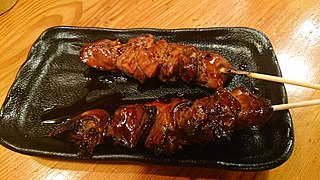| This article needs additional citations for verification. Please help improve this article by adding citations to reliable sources. Unsourced material may be challenged and removed. Find sources: "Yakitori" – news · newspapers · books · scholar · JSTOR (August 2012) (Learn how and when to remove this message) |


Yakitori (Japanese: 焼き鳥) (literally 'grilled bird') is a Japanese type of skewered chicken. Its preparation involves attaching the meat to a skewer, typically made of steel, bamboo, or similar materials, after which it is grilled over a charcoal fire. During or after cooking, the meat is typically seasoned with tare sauce or salt. The term is sometimes used informally for kushiyaki (grilled and skewered foods) in general.
Preparation
As it is designed for convenience and portability, yakitori is typically cooked using step-by-step methods. Traditionally, it was accomplished using portable charcoal grills. That is the method most often employed by yatai, however, restaurants may use stationary grills and, depending on the situation, higher quality binchōtan charcoal.
At home, appliances known as takujō konro (卓上コンロ, "mini griller") or yakitori-ki (焼き鳥器, "yakitori device") are used. Yakitori-ki are small electrical appliances that use a heating element similar to that of a broiler or toaster to cook the food placed on top.


To facilitate even cooking, the meat is cut into small, roughly uniform shapes and then skewered with kushi; after which the yakitori are seasoned and cooked. Charcoal is the preferred method of cooking as it produces high heat and strong flames while giving off little to no water vapor. This allows the ingredients to cook quickly while imparting a crunchy texture to the skin. Although gas and electric heat sources can be used, they do not develop the same aromas or textures as charcoal-cooked yakitori.
Seasoning
Yakitori seasonings are primarily divided into two types: salty or salty-sweet. The salty type usually uses plain salt as its main seasoning. For the salty-sweet variety, tare, a special sauce consisting of mirin, sake, soy sauce, and sugar is used. Other common spices include powdered cayenne pepper, shichimi, Japanese pepper, black pepper, yuzu kosho and wasabi, according to one's tastes.
Sales
Yakitori-ya (焼き鳥屋) are small shops specializing in yakitori. They usually take the form of a compact shop offering take-out services only, but sit-down restaurants and restaurant chains are also popular.
Yakitori is not limited to speciality shops: It is readily found on the menus of izakaya all across Japan and is sold pre-cooked, as frozen vacuum packs, or even canned. The latter was made popular by Hotei Foods Corporation, the first company that started selling yakitori-in-can in 1970, with nine flavors as of 2016. Their TV commercial song has been iconic to their brand name.
Due to its ease of preparation and portability, yakitori becomes a very popular street food that is often sold from small carts and stalls, known as yatai. Yatai are found, among other places, dotting streets during festivals or on heavily trafficked routes during the evening commute where customers enjoy beer and sake with yakitori.
Examples
Due to a wide diversity in cuts and preparation methods, yakitori takes on many forms. Some popular examples include:
- momo (もも), chicken thigh
- mune (むね), chicken breast
- hasami (はさみ), gizzard and spring onion
- sasami (ささみ), inner breast meat or "tender"
- negima (ねぎま), chicken and spring onion
- tsukune (つくね), chicken meatballs
- (tori)kawa ((とり)かわ), chicken skin, grilled until crispy
- tebasaki (手羽先), chicken wing
- bonjiri (ぼんじり), chicken tail
- shiro (シロ), chicken small intestines
- nankotsu (なんこつ), chicken cartilage
- hāto / hatsu (ハート / ハツ) or kokoro (こころ), chicken heart
- rebā (レバー), liver
- shiro rebā (白レバー) fatty Liver
- sunagimo (砂肝) or zuri (ずり), chicken gizzard
- toriniku (鶏肉), all white meat on skewer
- yotsumi (四つ身), pieces of chicken breast
- seseri (せせり), chicken neck meat
Gallery
-
 Left to right: Kawa (chicken skin); yamaimo; shishitō
Left to right: Kawa (chicken skin); yamaimo; shishitō
-
 Chicken liver
Chicken liver
-
 Left to right: Tsukune; negi (scallion) and butabara (pork back ribs)
Left to right: Tsukune; negi (scallion) and butabara (pork back ribs)
-
 Negima (chicken thigh and scallion)
Negima (chicken thigh and scallion)
See also
- Brochette
- Barbecue
- Chuanr – China
- Dak-kkochi – Korea
- Japanese cuisine
- List of chicken dishes
- List of kebabs
- Nem nướng – Vietnam
- Satay – Indonesia
- Shashlik - Caucasus and Eastern Europe
- Souvlaki – Greece
References
- ^ "Yakitori (Roast meat on skewers), dated 10 May, 2010". Gurunavi. Retrieved 2016-02-14.
- "jūshībōi". Archived from the original on 2016-02-16. Retrieved 2016-02-14.
- Kawaguchi, Judit. "People – Words to Live by: Chicken one day doesn't mean feathers on the next". the Japan Times. Retrieved 2016-02-14.
- "catalog – cooked meat cans". Hotei Foods Corporation. Archived from the original on 2016-02-16. Retrieved 2016-02-14.
- "CM gallery". Archived from the original on 2016-02-16. Retrieved 2016-02-14.
- Goss, Rob (2014-11-18). Tokyo Tuttle Travel Pack: Your Guide to Tokyo's Best Sights for Every Budget. Tokyo: Tuttle Publishing. p. 66. ISBN 9781462916306.
Further reading
- Ono, Tadashi; Salat Harris (2011). The Japanese Grill: From Classic Yakitori to Steak, Seafood, and Vegetables. Ten Speed Press. ISBN 9781580087377
- Itoh, Makiko (2015-08-21). "How yakitori went from taboo to salaryman snack". the Japan Times. Tokyo. Retrieved 2016-02-14.
- "Yakitori (Roast meat on skewers)". Gurunavi. Retrieved 2016-02-14.
External links
| Japanese food and drink | |||||||||
|---|---|---|---|---|---|---|---|---|---|
| Shushoku |
| ||||||||
| Okazu | |||||||||
| Soup (Shirumono) | |||||||||
| Set menu | |||||||||
| Beverages |
| ||||||||
| Snacks
/ sweets/ Wagashi | |||||||||
| Fruits | |||||||||
| Ingredients / Condiments | |||||||||
| Utensils | |||||||||
| Lists | |||||||||
| Related | |||||||||
